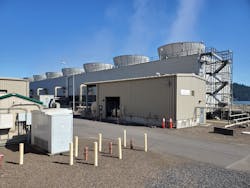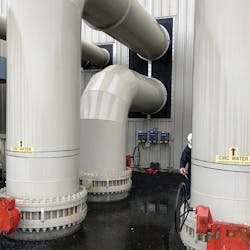Product Focus: Water Treatment with Pulsed Low-Frequency Signals
Chemistry has been the long-established standard for water treatment. To maintain efficient cooling systems, operators have had little choice but to use chemical treatment to manage mineral scaling and biofouling. While the industry accepts these chemicals as necessary, the substances have always posed risks. Those risks include challenges to operators and the environment — including personnel safety, hazardous storage and discharge, and expensive ongoing costs.
Over the years, inventors have created dozens of non-chemical water treatment methods. Nearly all these devices have produced inconsistent results. This is due to one underlying flaw: each of these technologies depends on flow. In other words, they rely upon the water in the system to flow through the device to have any effect on scale or bacteria. And if the flow rate is too high or the system too large, the devices never have a chance to completely treat the water. These technologies often allow cooling towers and related equipment to fall victim to fouling. This leaves the industry hesitant about chemical-free treatment options.
This article introduces Flow-Tech, a chemical-free technology that meets the expectations of industrial and power applications. Originating from the oil and gas industry, its unique omnipresent treatment coupled with extensive third-party validation has proven to be a reliable solution that industry experts can use as a viable approach to chemical-free water treatment. Today, power plants across North America are turning to this technology to mitigate fouling issues, save water and reduce their dependency on chemicals.
Legitimizing chemical-free water treatment
Flow-Tech transmits a pulsed low-frequency signal into the system, which then propagates throughout the piping network, treating all the fluid. Its non-invasive installation allows for versatility in both retrofit and new-build applications with zero intervention or cutting of pipes required. Once installed, the patented technology ensures systemwide protection.
Flow-Tech Systems first developed its patented electronic treatment technology in 2011 for use in onshore and offshore oil and gas wells. Due to the mineral rich water extracted during oil production, wells are vulnerable to extreme fouling and often required costly maintenance shutdowns and chemical intervention. Operators around the globe now rely on pulsed low-frequency technology. This method protects their production and surface processing equipment — often stretching thousands of feet deep — with a low-cost, safe and environmentally friendly alternative to chemicals. In doing so, their operations save millions in remediation work and lost production each year.
Embracing third-party validation
Since its founding, Flow-Tech Systems has embraced third-party validation of its technology. Flow-Tech has entered each of its markets — from residential plumbing and commercial HVAC to power plants and desalination — with scientific backing before making claims on a given application.
In 2009, the American Society of Heating, Refrigerating, and Air-Conditioning Engineers (ASHRAE) commissioned a study through the University of Pittsburgh to test chemical-free treatment systems and their effectiveness in controlling sessile bacteria (biofilm) in cooling water systems. Of the original technologies tested — including magnetic, electromagnetic, and ultrasound — no device showed an ability to reduce microbial growth rates compared to the control. In 2012, after Flow-Tech incorporated, researchers evaluated its technology using the same protocol at the university and achieved a 98% inhibition of sessile bacteria.
In 2020, Montana State University’s Center for Biofilm Engineering conducted a similar evaluation. By the end of the two-month study, the Flow-Tech system had approximately 80-90% fewer live biofilm cells than the control.
How it works
Utilizing the conductance of the fluid itself, Flow-Tech’s engineers achieved an omnipresent treatment signal. That signal was measurable and verifiable both upstream and downstream of the physical installation, regardless of the flow rate. Pulsed low-frequency treatment is equivalent to lining the entire piping system with chamber systems. With this technology, the conductance of the signal allows for consistent treatment of the fluid throughout the system.
Success in the field
Flow-Tech’s solution provides a unique and effective alternative to chemicals in a wide array of applications. Organizations ranging from Fortune 100 technology companies to heavy industrial processors have standardized on this method as a key component of their water treatment. Several of the country’s largest power companies are turning to pulse signal treatment to reduce their chemical usage, achieve environmental and sustainability goals, and improve safety of their operators. A 248 MW cogeneration power plant leveraged this method to address challenges within its 75,000 gallons per minute (GPM) cooling water system. Those challenges included silica scale, high bacteria counts and a chemical-resistant strain of algae. Within months, the facility eliminated an expensive silica inhibitor and measured more than a 90% reduction in bacteria counts. Today, three years after the system first went online, the facility has maintained a steady heat rate. It has also measured consistently low bacteria counts, seen no further accumulation of silica scale on its equipment and eliminated a majority of its once relied-upon chemicals.
Outside of power, one of the world’s largest reverse osmosis manufacturers uses this technology to prevent biofouling in the pretreatment stage. Hospitals also have implemented signal treatment to maintain low bacteria counts and mitigate the threat of legionella in cooling towers. A small-scale version of the same technology is used in residential homes as an alternative to ion exchange systems. To date, home builders have deployed more than 75,000 units to prevent hard water scale from damaging plumbing and water heaters. Several of the country’s largest and most reputable plumbing contractors offer the technology to their homeowners.
Transitioning to chemical-free
With the need for sustainable practices on an exponential rise, chemical-based water treatment restricts a power plant’s ability to achieve environmental goals. Flow-Tech’s water treatment technology provides facilities with an effective solution to address their immediate water needs while stepping down their dependence on chemicals. In doing so, power plants are empowering themselves to reduce chemical usage, save water, extend equipment life and improve their operations.
About the Authors: Mark Meyer is the Founder, Gary Post is an engineer, and Kevin Brauer is in business development, all at Flow-Tech Systems, a leader in chemical-free water treatment based in Milwaukee, Wisconsin. For more information about the company, go to https://www.flowtechsystems.com.

